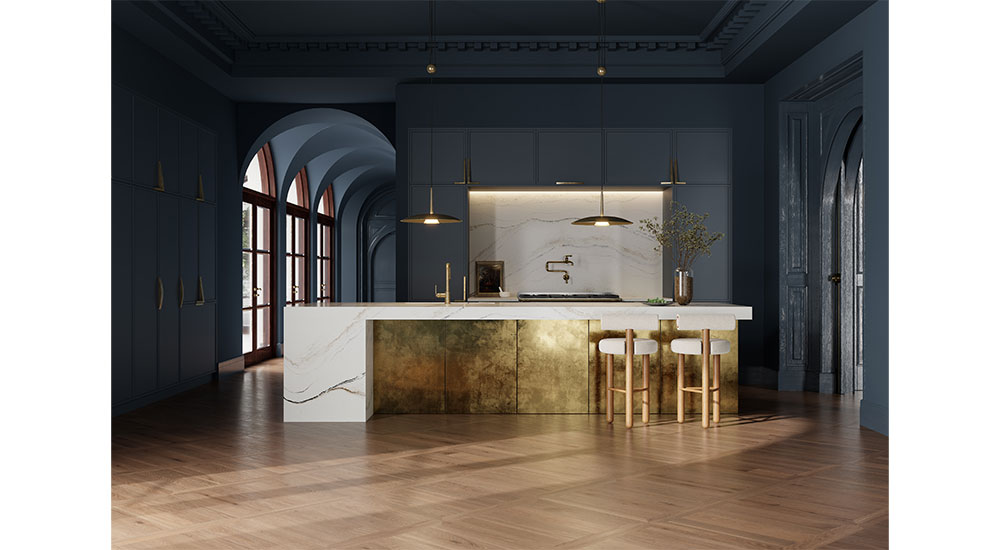I have learned through my work on designing Cambria quartz surfaces that interior design is an intricate dance of color, light, materials and forms. Among these elements, texture plays an often underappreciated yet essential role in elevating spaces and imparting depth and sensory appeal. My conversations with designers around North America and my travels have led me to understand why texture is a designer’s secret weapon and how it enhances modern interiors.
For professional designers, success isn’t just about meeting a client’s aesthetic vision – it’s about creating spaces that inspire. In today’s competitive interior design world, texture is more than a design tool; it’s a strategic advantage that transforms interiors, enhancing both their functionality and emotional appeal.
Shown above is Cambria Lakedale (™)
Transforming Flat Spaces into Dimensional Masterpieces
Most designers’ customers dream of a space that feels alive, layered and rich in detail. Texture brings this vision to life by adding depth and dimension. Imagine the pairing of countertops finished in Cambria Satin™ with the rugged warmth of reclaimed wood cabinets or the contrast of soft velvet upholstery against the sheen of metallic light fixtures. These combinations create environments that are not only visually striking but also memorable.
For designers, these choices help elevate a project’s value. Textural layering draws the eye and makes spaces more photogenic, increasing their appeal for portfolios, social media and word-of-mouth promotion.

Ethan Charles Design – Cambria Inverness Platinum(™)
“We look for opportunities to infuse texture everywhere we can, from walls and furniture to unexpected surfaces,” said Ethan Greenfeld, founder & principal designer at Ethan Charles Design. “One of our favorite ways to do this is by incorporating Cambria’s line of debossed slabs. They offer unexpected texture on a surface we ordinarily think of as being smooth and uninteresting, which just expands the places we can incorporate texture in our designs. We love Cambria’s newly released Inverness Stonestreet™ design; it is elegant, durable and features sophisticated natural textures enhanced by deep charcoal hues.”
Crafting Emotional & Sensory Connections
Design today is about more than how a space looks – it’s about how it feels. Texture can evoke specific emotions and sensations, transforming a house into a home or a retail space into an experience. Soft materials like velvet and faux fur create a sense of warmth and coziness, while sleek surfaces like polished quartz exude modern sophistication. Cambria’s satin finish adds visual depth and subtle texture, elevates the design aesthetic and reduces glare for a softer, more refined look.
The sensory appeal of texture goes beyond visuals. The tactile contrast between a matte backsplash and a glossy quartz island countertop invites interaction, making spaces engaging and unforgettable. By designing for the senses, professionals create experiences that clients deeply appreciate – and are more likely to recommend.
Bridging Aesthetic Boundaries with Texture
We are hearing that in interior design, clients increasingly want spaces that blend styles – rustic charm with contemporary flair or traditional elegance with modern minimalism. Texture is the bridge that connects these disparate elements, ensuring harmony while preserving the distinctiveness of each.
For example, pairing a rustic wooden dining table with sleek quartz finishes creates a seamless fusion of old and new. These thoughtful combinations demonstrate versatility and creative problem-solving, key attributes that position designers as leaders in the industry.

Cambria Everleigh Warm(™)
Texture’s Dance with Light
Texture doesn’t just add dimension, it interacts with light to create dynamic spaces that shift and evolve throughout the day. Subtly veined quartz, grooved wood paneling or satin finishes reflect and diffuse light in unique ways, offering ever-changing aesthetics.
This interplay of texture and light gives spaces a sense of movement and life, delighting clients with designs that feel fresh and inspiring every time they enter. It’s a powerful way to enhance the longevity and impact of a project.
Personalizing Spaces with Bespoke Textures
Texture allows designers to infuse projects with character and personality. Woven cabinet fronts, hand-carved details or textured feature walls transform functional elements into standout elements. These custom touches set designs apart, reflecting a client’s unique identity while showcasing a designer’s creative expertise. Bespoke textures also signal exclusivity, positioning designers as creators of one-of-a-kind spaces. This can justify higher fees and reinforce the designer’s reputation for excellence.
“In our design philosophy, texture isn’t just a detail – it’s the foundation of everything we create,” said Greenfeld. “We believe there can never be too much texture in a space. Texture has the unique ability to transform a room, creating depth, warmth and visual interest without relying heavily on color. It’s a powerful tool that can take a neutral palette and make it feel alive, engaging, and inviting.”
Texture as a Strategic Design Pillar
Texture isn’t just an aesthetic enhancement, it’s a tool for building emotional resonance, delivering value and creating unforgettable spaces. Texture is the soul of a space; it brings personality and energy into a design. By embracing texture, designers can exceed client expectations, elevate their brand and position themselves as innovators in a competitive industry. How will you use texture to leave your signature on every project?








